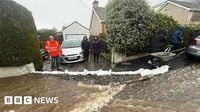As dawn broke on October 19, 2025, residents at the foot of the Mourne Mountains in County Down awoke to a scene many described as unprecedented. After two days of relentless rainfall—amounting to nearly 100 millimetres, according to the UK's Met Office—the usually tranquil streets of Newcastle were transformed into surging rivers, testing the resilience and resourcefulness of the local community.
The Met Office had issued a status yellow heavy rain alert for most of Northern Ireland, but it was Down that bore the brunt. Water poured down from the Mournes, carrying with it stones, gravel, and debris that choked roads and overwhelmed drainage systems. For those living on Sunningdale Drive and Tullybrannigan Road, the deluge was both a spectacle and a threat. "I’ve lived here for 18 years and have never seen anything like this," said Avril Tinson, whose bungalow narrowly escaped flooding. "The water came rushing down the street and my house was the natural place for it to go. But neighbours helped build a barrier using some of the stones and later some sandbags arrived and that stopped the water getting into the house down the driveway. I’m still a bit concerned because there’s still so much water in the mountains. Hopefully we’re going to be alright, but I couldn’t have done it without the neighbours." (RTÉ News)
Community spirit was on full display as residents, some armed with nothing more than shovels and determination, joined statutory agencies to stave off the worst. Stones and gravel washed down from mountain paths were hastily piled into makeshift barricades, bolstered by sandbags supplied by Stormont’s Department for Infrastructure (DfI). According to BBC News NI, more than 900 sandbags were deployed in the area, with diggers and lorries brought in to clear blocked roads and drains. Local people, like Peter Law, worked tirelessly to clear leaves and debris from drains. "With the hill behind us all the water is just coming right down here. The drains are blocked because of the leaves, we're doing our best here with limited resources trying to clear out the drains," Law told BBC News NI. He recalled, "I remember as a youngster going up and down in a canoe in the floods of '66 so it's nothing new but it does happen every so often, and with all the recent building going on around here, the amount of drainage—the sewers and drains just can't cope."
The situation was especially dire for some. Alliance Party councillor Jill Truesdale, who lives in the area, described the water "funnelling down the mountain" and the fear that came with it. "I've never seen so much debris come down before, it's quite frightening," she told BBC News NI. Trapped in her home with her family due to the flooding and a coinciding high tide, Truesdale remarked, "It looks as if we are going to be [trapped] for a while because there's also a high tide so we won't be leaving, it's not worth the risk."
Vehicles struggled to navigate the transformed landscape, with 4x4s managing where ordinary cars could not. "It is particularly bad on Sunningdale Drive, which runs on to Tullybrannigan Road," said Samuel Guist, another local resident. "4X4s are able to get up and down, but most cars are avoiding it." Guist recounted the shock among longtime residents: "One of my neighbours who has lived here for 40 years said he has never seen anything like it."
The Department for Infrastructure emphasized the scale of the response, stating their teams had been "on standby all weekend following the Met Office weather warning issued." Staff worked around the clock, deploying sandbags, clearing blockages, and monitoring flood-prone areas. A spokesperson explained that the flooding was caused by "surface water run-off from the Mourne Mountains" rather than overflowing rivers, a distinction that shaped the emergency response (RTÉ News).
Despite the chaos, the collective effort between residents and officials was notable. Sinn Féin councillor Willie Clarke, who was seen helping move sandbags, praised the response: "The statutory agencies have done a very good job to protect homes, but we do need to look at why drains were blocked as that made the situation worse." He added, "There has always been an issue with dealing with water capacity in the Tullybrannigan area. The issues about the reasons for it can be dealt with at a later date, it's about protecting homes at the minute." Clarke also highlighted the community's response: "All the community has been out helping their neighbours and I want to thank them and also the statutory bodies who have been out from all hours."
The flooding’s impact wasn’t limited to homes and roads. In the heart of the Mourne Mountains, a hiker found themselves cut off by swollen rivers after camping overnight in the Annalong Valley. The Mourne Mountain Rescue Team, responding to a police request, mounted a successful rescue operation. According to the rescue team, "Having camped in the valley overnight and expecting heavy rain, but not accounting for the impact of flooded rivers, the camper awoke cut off from several approaches. Wet, cold and concerned about navigating accurately in the conditions, the individual rightly sought help." Five team members responded, escorting the hiker out via the Ben Crom Valley and avoiding dangerous river crossings. The team stood down at 4 pm, with a spokesperson reminding the public: "Heavy rain can have an impact beyond the obvious, including on what is safe and accessible when flooding occurs. Looking ahead to how an area may change due to incoming weather can help avoid a bad experience." (BBC News NI)
Elsewhere, the impacts of the storm were felt in places like Beragh in County Tyrone, where saturated ground left residents wary of more rain. Barry McGuinness, a local, described Beragh as a "bit of a basin" and noted, "If there's any rain here we are flooded. Many parts of the town have flood barriers, but a lot of time they don't do the job. The local GAA pitch is normally the first to go," he said, recalling a year when the clubhouse filled with water. "It's a very close community so you do feel for anyone affected by the weather in these circumstances."
The yellow weather warning, initially issued for Antrim, Armagh, and Down, was extended to parts of Londonderry and Tyrone and remained in place until 15:00 BST. As the alert expired, DfI reported that roads staff continued to monitor the situation and help remove blockages, stating there were "no significant issues in other areas at present." Residents impacted by flooding were reminded they could contact the Flood Incident Line for assistance with sandbags.
With the ground now saturated and the threat of further rainfall looming, many in County Down and beyond remain vigilant. While the worst may have passed for now, the events of October 2025 serve as a stark reminder of the power of nature and the importance of community in the face of adversity.





